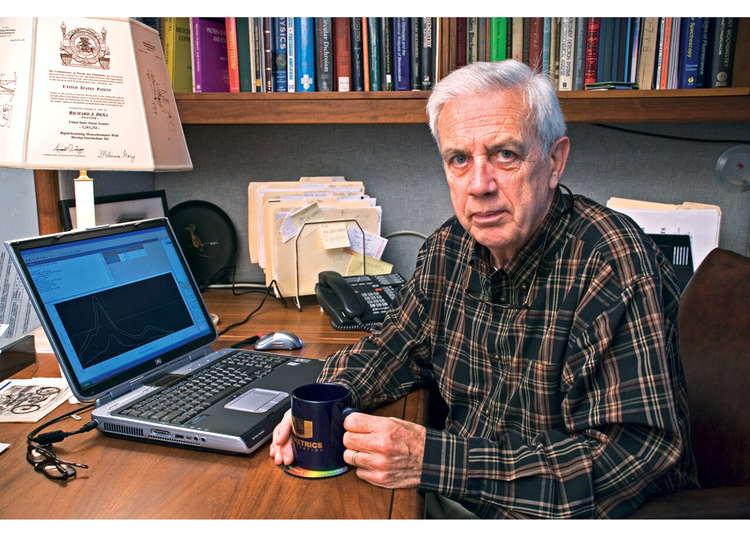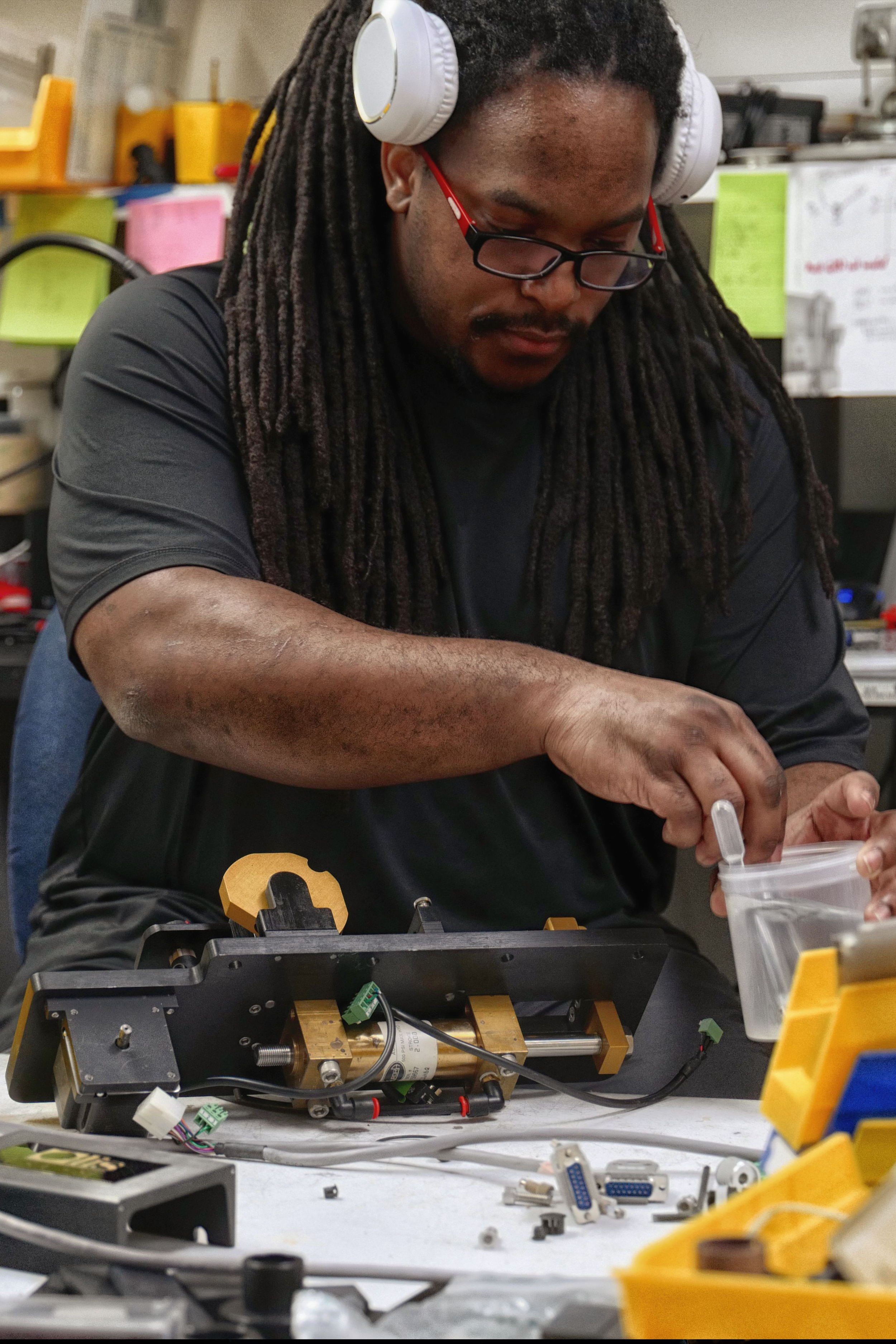Some Ideas on Uv/vis/nir You Need To Know
Some Ideas on Uv/vis/nir You Need To Know
Blog Article
The Basic Principles Of Uv/vis
Table of ContentsThe Main Principles Of Uv/vis Uv/vis Fundamentals ExplainedAn Unbiased View of Uv/visSpectrophotometers for DummiesLittle Known Facts About Uv/vis/nir.Not known Facts About SpectrophotometersAll About Uv/visThe 8-Minute Rule for Circularly Polarized LuminescenceUv/vis - TruthsThings about Circularly Polarized LuminescenceFacts About Circularly Polarized Luminescence UncoveredNot known Details About Spectrophotometers What Does Circular Dichroism Mean?
It is then scanned through the sample and the recommendation services. Portions of the occurrence wavelengths are transmitted through, or shown from, the sample and the referral. The resultant light strikes the photodetector device, which compares the relative strength of the two beams. Electronic circuits convert the relative currents into linear transmission percentages and/or absorbance/concentration values.The transmission of a referral substance is set as a standard (information) worth, so the transmission of all other substances are recorded relative to the preliminary "zeroed" substance. The spectrophotometer then converts the transmission ratio into 'absorbency', the concentration of particular parts of the test sample relative to the preliminary substance.
Considering that samples in these applications are not readily available in large amounts, they are particularly matched to being analyzed in this non-destructive method. In addition, valuable sample can be conserved by making use of a micro-volume platform where as little as 1u, L of sample is required for complete analyses. A quick explanation of the treatment of spectrophotometry consists of comparing the absorbency of a blank sample that does not include a colored compound to a sample that consists of a colored compound.
7 Simple Techniques For Circularly Polarized Luminescence
In biochemical experiments, a chemical and/or physical property is chosen and the procedure that is utilized is particular to that residential or commercial property in order to obtain more details about the sample, such as the quantity, purity, enzyme activity, and so on. Spectrophotometry can be utilized for a variety of strategies such as determining optimum wavelength absorbance of samples, determining optimal p, H for absorbance of samples, identifying concentrations of unidentified samples, and determining the p, Ka of various samples.: 21119 Spectrophotometry is likewise a handy procedure for protein filtration and can also be utilized as a method to create optical assays of a compound.
It is possible to understand the concentrations of a 2 part mix utilizing the absorption spectra of the standard services of each component. To do this, it is necessary to understand the termination coefficient of this mixture at two wave lengths and the termination coefficients of options which contain the recognized weights of the 2 components.

The Basic Principles Of Spectrophotometers
Many spectrophotometers are utilized in the UV and visible areas of the spectrum, and a few of these instruments also operate into the near-infrared area also. The concentration of a protein can be estimated by measuring the OD at 280 nm due to the presence of tryptophan, tyrosine and phenylalanine (http://www.video-bookmark.com/bookmark/6114703/olis-clarity/).
Nucleic acid contamination can likewise interfere. This approach needs a spectrophotometer efficient in measuring in the UV area with quartz cuvettes.: 135 Ultraviolet-visible (UV-vis) spectroscopy involves energy levels that delight electronic shifts. Absorption of UV-vis light thrills particles that are in ground-states to their excited-states. Visible region 400700 nm spectrophotometry is used extensively in colorimetry science.
These curves can be used to evaluate a new batch of colorant to inspect if it makes a match to specs, e
Traditional visible standard spectrophotometers area not detect if identify colorant or the base material has product. This can make it hard to handle color problems if for example one or more of the printing inks is fluorescent. There are 2 major setups for visual spectrum spectrophotometers, d/8 (round) and 0/45.
Researchers utilize this instrument to determine the quantity of compounds in a sample. In the case of printing measurements 2 alternative settings are commonly utilized- without/with uv filter to manage better the impact of uv brighteners within the paper stock.
Circular Dichroism Can Be Fun For Everyone
Some applications need little volume measurements which can be carried out with micro-volume platforms. As explained in the applications section, spectrophotometry can be used in both qualitative and quantitative analysis of DNA, RNA, and proteins. Qualitative analysis can be used and spectrophotometers are utilized to tape-record spectra of compounds by scanning broad wavelength regions to figure out the absorbance homes (the intensity of the color) of the compound at each wavelength.

Uv/vis/nir Fundamentals Explained
One significant factor is the type of photosensors that are offered for various spectral areas, however infrared measurement is also challenging because virtually whatever produces IR as thermal radiation, specifically at wavelengths beyond about 5 m. Another complication is that quite a few products such as glass and plastic absorb infrared, making it incompatible as an optical medium.
Samples for IR spectrophotometry may be smeared in between 2 discs of potassium bromide or ground with potassium bromide and pressed into a pellet. Where aqueous solutions are to be determined, insoluble silver chloride is used to build the cell. Spectroradiometers, which operate nearly like the noticeable area spectrophotometers, are designed to determine the spectral density of illuminants. Retrieved Dec 23, 2018. Essential Lab Techniques for Biochemistry and Biotechnology (2nd ed.). The vital guide to analytical chemistry.
Oke, J. B.; Gunn, J. E.
Spectrophotometers for Beginners

1021/ac50048a728. ISSN0003-2700. Ninfa AJ, Ballou DP, Benore M (2015 ). Essential Lab Techniques for Biochemistry and Biotechnology (3, rev. ed.). Hoboken, NJ: Wiley & Sons. p. 77. ISBN9780470924525. OCLC915641828. "Completely Automatic Double Beam - Atomic Absorption Spectrophotometer (AA 8000)". Laboratory Devices. Labindia Analytical Instruments Pvt. Ltd. "Spectrophotometry Applications and Fundamentals".
The Basic Principles Of Uv/vis
"Applied Spectrophotometry: Analysis of a Biochemical Mix". Biochemistry and Molecular Biology Education. Journal of Biochemistry Education.
The 6-Minute Rule for Uv/vis/nir
U.S. Department of Commerce National Bureau of Standards special publication; 378. Washington, D.C.: U.S. National Bureau of Standards. p. 2. OCLC 920079.
The procedure starts with a regulated source of light that illuminates the evaluated sample. When it comes to reflection, as this light interacts with the sample, some is soaked up or produced. The discharged light travels to the detector, which is evaluated, quantified, and provided as industry-standard color scales and indices.
Industry governing bodies normally specify specific metrics for specific items, such as Tomato and Coffee indices. The simplified math appears like this: Where R is the reflection coefficient. All terms are examined over the noticeable spectrum from 400 to 700 nm. When it comes to transmission, when the light communicates with the sample, it is either absorbed, reflected, or transferred.
How Circular Dichroism can Save You Time, Stress, and Money.
Examples include APHA (American Public Health Association) for watercolor and purity analysis, ASTM D1500 for petrochemical color analysis, edible oil indices utilized in food, and color analyses of drinks. The simplified mathematics appears like this:. Where T is the transmission coefficient. All terms are assessed over the visible spectrum from 400 to 700 nm.
Image Credit: Matej Kastelic/ Dr. Arnold J. Beckman and his colleagues at the National Technologies Laboratories first developed the spectrophotometer in 1940. In 1935 Beckman established the company, and the discovery of the spectrophotometer was their most ground-breaking development. Dr. Bruce Merrifield, a Nobel prize-winning biochemist, stated that the development of the spectrophotometer was "probably the most essential instrument ever developed towards the development of bioscience." Before the discovery of the spectrophotometer, chemical analyses took weeks to complete, with 25% precision.
9 Easy Facts About Uv/vis Shown
Over time, scientists kept enhancing the spectrophotometer design to enhance its performance. The UV capabilities of the design B spectrophotometer were improved by changing the glass prism with a quartz prism.
After 1984, double-beam variations of the gadget were created. The addition of external software application with the arrangement of onscreen displays of the spectra was available in the 1990s. Normally, a spectrophotometer is comprised of 2 instruments, particularly, a spectrometer and a photometer. A basic spectrophotometer contains a source of light, a monochromator, a collimator for straight light beam transmission, a cuvette to place a sample, and a photoelectric detector.
Excitement About Uv/vis
There are different kinds of spectrophotometers in different shapes and sizes, each with its own purpose or performance. A spectrophotometer determines how much light is shown by chemical parts. UV/Vis. It determines the difference in light intensity based on the total amount of light presented recommended you read to a sample and the quantity of light beam that passes through the sample service
Based on the instrument's style, the sample is placed in between the spectrometer and the photometer. After the light is passed through the sample, the photometer measures its intensity and displays the reading. A spectrophotometer is utilized to figure out the concentration of both colorless and colored solutes in an option. This instrument is utilized to figure out the rate of a reaction.
Report this page